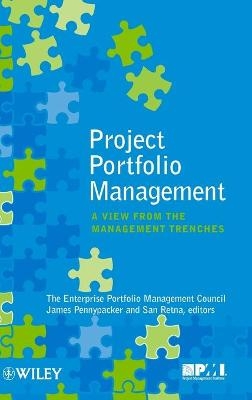
Project Portfolio Management
John Wiley & Sons Inc (Verlag)
978-0-470-50536-6 (ISBN)
Written by ten successful project portfolio managers from companies including AAA, Boeing, Franklin Templeton, Johnson & Johnson, Safeway, and the UK Government, this easy-to-follow guide takes you through the project portfolio management process. It's based on what actually works, giving you a clear road map and the tools needed to determine the optimal mix and sequencing of projects in order to meet your organization's goals. The book begins by explaining basic PPM principles and why PPM is more critical than ever for business success. This introduction is followed by a story, tracking the experiences of a manager new to PPM as he discovers the issues that all of us face in trying to get traction with our PPM initiatives. In answering the questions our story raises, the book then details each step of the PPM process, using cases and examples drawn from the authors' first hand experience to help you address such key questions as:
Which projects should our organization invest in?
How can we optimize our organization's capacity?
How well are we executing the PPM process?
Can our organization absorb all the changes that our PPM plan requires?
Are we achieving all the expected benefits?
The authors are all members of the Enterprise Portfolio Management Council, a group of senior portfolio management executives dedicated to helping organizations develop their own portfolio management capabilities. Now you can benefit from their collective wisdom and experience, and duplicate their successful results within your own organization.
James Pennypacker has directed benchmarking projects on management topics, including strategy and projects, portfolio management, PMOs, and process maturity. He is the author/editor of several books, including Seven Steps to Strategy Execution, Project Portfolio Management Maturity Model, and Managing Multiple Projects. San Retna has spent over twenty years deploying and operating project, program, and portfolio management capabilities. He is the Vice President of IT Effectiveness at Safeway, Inc. As a thought leader, he has been profiled in numerous publications including CFO magazine, CIO magazine, Computerworld, and PM Network. Case studies of successes have also been published by Gartner, Corporate Executive Board, and the Project Management Institute.
Foreword. Preface.
Why We Created the EPMC.
Why We Wrote the Book.
About the Authors.
About the EPMC.
Acknowledgements.
Part I Introduction.
1 What is Project Portfolio Management?
Introduction.
Successful PPM.
The Five Questions in Brief.
Project Portfolio Management Defined.
The PPM Players and Roadmap.
The PPM Process Views.
A Few More Questions to Get the Mental Synapses Firing.
Chapter Summary.
Part II Project Portfolio Management: A Story.
2 Introduction.
10 Years Ago . . ..
Present Day . . ..
Later that afternoon . . ..
3 Are We Investing in the Right Things?
EPMC Working Document on Portfolio Investment.
4 Are We Optimizing Our Capacity?
Demand-Side Resource Management.
Supply-Side Resource Management.
Conclusion.
EPMC Working Document on Portfolio Resource.
Optimization.
5 How Well Are We Executing?
6 Can We Absorb All the Changes?
Defining Change.
Types of Change.
Modeling the Impact of Change.
Controlling the Impact of Change.
Conclusion.
EPMC Working Document on Enterprise Change Management.
7 Are We Realizing the Promised Benefits?
Key 1: Ensuring All Benefits Claimed Are Robust and Realizable.
Key 2: Capturing All Value Created.
Key 3: Moving beyond Benefits Realization to Value Creation.
Conclusion.
EPMC Working Document on Benefits Realization.
Part III Operating Considerations.
8 The PPM Process.
PPM Components.
The Project Proposal.
Project Proposal Approval.
The Business Case and Project Management Plan.
Project Prioritization.
Project Authorization.
Project Execution and Review.
Chapter Summary.
9 Setting the Foundation for Success.
The Business Case Foundation.
The Benefits of PPM.
The People Foundation.
The Process Foundation.
The Technology Foundation.
Tying It All Together: People, Process, Technology.
Chapter Summary.
10 PPM Design.
PPM’s Seven Ps.
Decision Criteria.
Source of Data and Information Related to Decision Criteria.
Scoring Projects and Portfolio.
Weighting Decision Criteria.
Drawing ‘‘The Line’’ in the Portfolio.
Link to the Business Case.
Business Case.
Link to the Portfolio.
A Few Parting Thoughts.
Chapter Summary.
11 Implementing PPM.
Executive Sponsorship.
Change.
Skills.
Structure.
Executive Steering Committee.
Governance Board (Decision Review Board).
Project Management Office.
Project Management Standards Committee.
Process Approach.
Capacity.
Demand.
Communication Plan.
Training.
Conclusion.
Chapter Summary.
12 Maintaining PPM.
Dashboards and Metrics: The Visuals.
Meetings: Keeping the Process Going.
Communication: Making Sure Everyone Is on the Same Page.
Maturity Models: Where Do You and Your Organization Stand?
Resource Management: Getting Your Arms around the Organization.
Keeping Up the Momentum.
Dedicating Resources to Running the PMO.
Chapter Summary.
Part IV The Story: Nine Months Later.
13 Bringing It All Together.
References.
Index.
| Verlagsort | New York |
|---|---|
| Sprache | englisch |
| Maße | 163 x 244 mm |
| Gewicht | 481 g |
| Themenwelt | Wirtschaft ► Betriebswirtschaft / Management ► Projektmanagement |
| ISBN-10 | 0-470-50536-2 / 0470505362 |
| ISBN-13 | 978-0-470-50536-6 / 9780470505366 |
| Zustand | Neuware |
| Haben Sie eine Frage zum Produkt? |
aus dem Bereich


